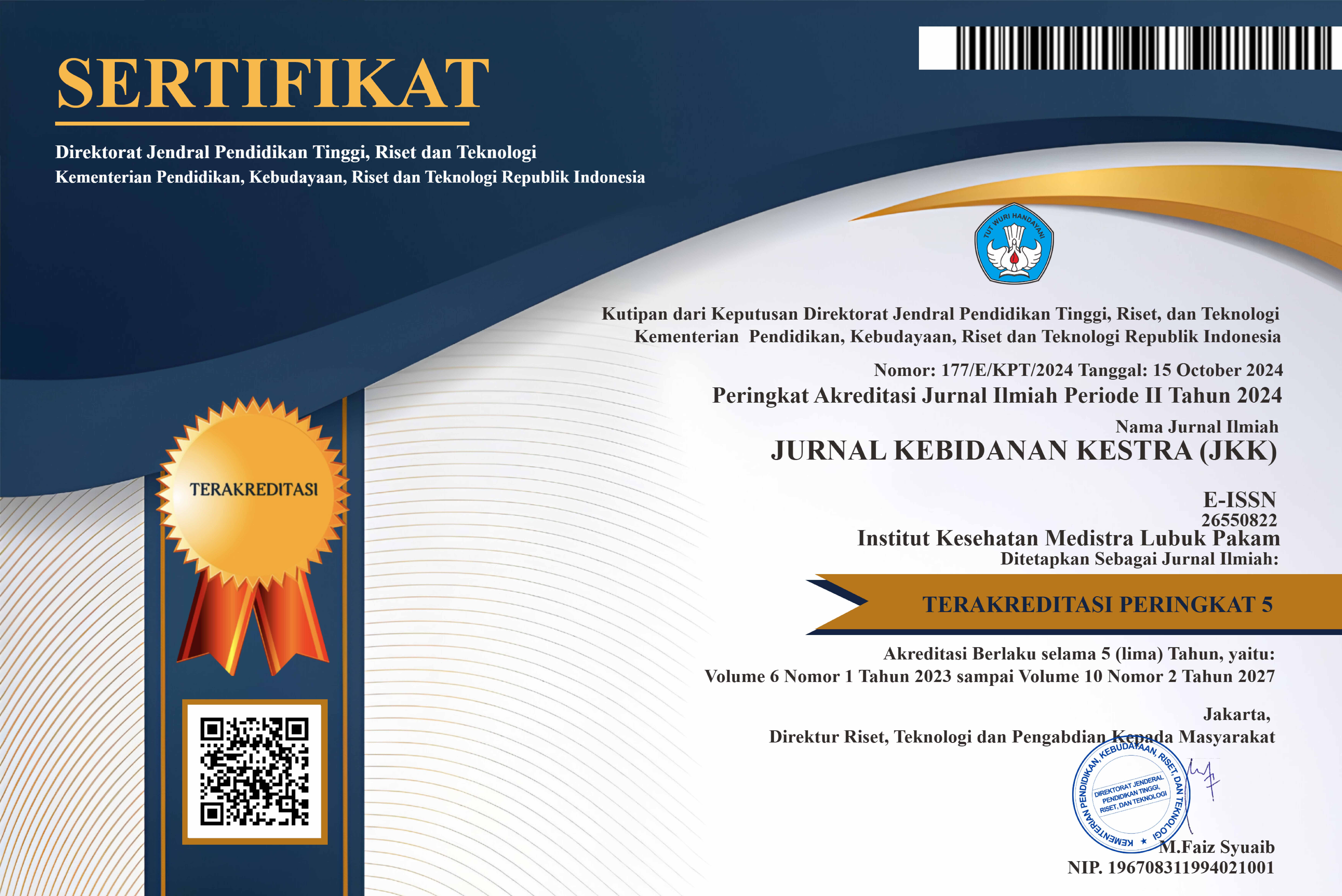Description of Birth Distance Related to the Risk of Stunting in Children At Dharma Women's Kindergarten Dukuh II, Ngaduluwih District
DOI:
https://doi.org/10.35451/jkk.v5i2.1586Keywords:
Jarak Kelahiran, StuntingAbstract
Stunting is a condition where a toddler experiences long-term failure to thrive due to malnutrition. The prevalence of stunting according to WHO in 2018, Indonesia is the third country with the highest average prevalence of stunting in the Southeast Asia/South-East Asia Regional (SEAR). The prevalence of stunting in East Java continues to decrease, but this has not reached the target set by the WHO of 20% and is still a major problem that occurs in toddlers. The incidence of stunting can be seen from two sides, namely toddlers and mothers. One of the risk factors from the mother's point of view is birth spacing. The purpose of this study was to get an overview of birth spacing related to the risk of stunting in Dharma Wanita Dukuh II Kindergarten, Ngadiluwih District. This type of research is descriptive and quantitative. The population in this study were all mothers with children under five who were in Kindergarten Dharma Wanita Dukuh II, Ngadiluwih District. The instrument used is a questionnaire. A univariate data analysis was performed to determine the frequency and percentage of research variables. The results of the study showed that the most common birth spacing was in the 2 year category with 24 respondents (68.6%). It is hoped that mothers who have a large number of children with close birth spacing can improve their parenting, not only in terms of nutritional needs but also the psychological needs of the child. The community must also begin to regulate birth spacing, considering this will affect the nutritional status of children, which can lead to stunting. In addition, there is a need to increase counseling related to birth spacing by medical personnel as a form of effort to prevent stunting.
Downloads
References
Abeway, S., Gebremichael, B., Murugan, R., Assefa, M., & Adinew, Y. M. (2018). Stunting and its determinants among children aged 6-59 Months in Northern Ethiopia: A cross-sectional study. Journal of Nutrition and Metabolism, 2018. https://doi.org/10.1155/2018/1078480
Aheto, J. M. K., Keegan, T. J., Taylor, B. M., & Diggle, P. J. (2015). Childhood Malnutrition and Its Determinants among Under-Five Children in Ghana. Paediatric and Perinatal Epidemiology, 29(6), 552–561. https://doi.org/10.1111/ppe.12222
Amini, A. (2016). Hubungan Kunjungan Antenatal Care (ANC) dengan Kejadian Stunting pada Balita Usia 12-59 Bulan di Kabupaten Lombok Utara Provinsi NTB Tahun 2016. Universitas Aisyiyah Yogyakarta, 2–22. Retrieved from file:///C:/Users/Acer/Downloads/anc.pdf
Aridiyah, F. O., Rohmawati, N., & Ririanty, M. (2015). Faktor-faktor yang Mempengaruhi Kejadian Stunting pada Anak Balita di Wilayah pesedaan dan perkotaan. Pustaka Kesehatan, 3(1), 163–170. https://doi.org/10.1007/s11746-013-2339-4
Camelia, V. (2020). Hubungan Antara Kualitas & Kuantitas Riwayat Kunjungan Antenatal Care (ANC) Dengan Stunting Pada Balita Usia 24-59 Bulan Di Kecamatan Pujon Kabupaten Malang. Journal of Issues in Midwifery, 4(3), 100–111. https://doi.org/10.21776/ub.joim.2020.004.03.1
Dedi Julianto, P. A. U. (2013). Analisa Pengaruh Tingkat Pendidikan Terhadap Pendapatan Individu Di Sumatera Barat. Journal of Chemical Information and Modeling, 53(9), 1689–1699.
Fadilah, T. F., & Eliafiana, R. (2022). Relationship between Mothers Birth Spacing and Incidence of Stunting in Children 24 - 59 months. Jurnal Biomedika Dan Kesehatan, 5(1), 42–49. https://doi.org/10.18051/jbiomedkes.2022.v5.42-49
Habo Abbas, H., Wulandari, N. A., Lestari, A., & Burhanuddin, N. (2020). Hubungan Riwayat Pola Menyusui, Usia Penyapihan dan Emotional Bonding terhadap Status Gizi pada Balita. Window of Health : Jurnal Kesehatan, (April), 116–122. https://doi.org/10.33368/woh.v0i0.249
Karundeng, L. R., Ismanto, A. Y., & Kundre, R. (2015). Hubungan Jarak Kelahiran Dan Jumlah Anak Dengan Status Gizi Balita Di Puskesmas Kao Halmahera Utara. Ejournal Keperawatan, 3(1), 1.
Kemenkes RI. (2015). Profil Kesehatan Indonesia Tahun 2015. In Kementerian Kesehatan RI (Vol. 3). Jakarta: Kemenkes RI.
Kemenkes RI. (2018a). Buletin Stunting. Kementerian Kesehatan RI, 301(5), 1163–1178.
Kemenkes RI. (2018b). Cegah Stunting, itu Penting. Pusat Data Dan Informasi, Kementerian Kesehatan RI, 1–27. Retrieved from https://www.kemkes.go.id/download.php?file=download/pusdatin/buletin/Buletin-Stunting-2018.pdf
Kemenkes RI. (2021). Buku Saku Hasil Studi Status Gizi Indonesia (SSGI).
Locitasari, Y. (2015). Perbedaan Pertumbuhan Bayi Usia 0-6 Bulan Yang Diberi Asi Eksklusif Dengan Yang Diberi Susu Formula Di Kecamatan Ngawi (Vol. 3). Universitas Muhammadiyah Surakarta.
Manggala, A. K., Wiswa, K., Kenwa, M., Me, M., Kenwa, L., Agung, A., … Sawitri, S. (2018). Risk factor of stunting. 58(5), 205–212.
Megantari, S. H., Abbas, H. H., & Ihktiar, M. (2020). Karakteritik Determinan Kejadian Stunting Pada Anak Balita Usia 24-59 Bulan Di Kawasan Kumuh Kecamatan Bontoala. Window of Public Health, 1(3), 207–219. Retrieved from https://doi.org/10.1016/j.cegh.2019.09.011
Pongrekun, P. S., Sunarsih, & Fatmawati. (2020). Faktor-Faktor Yang Berhubungan Dengan Kejadian Stunting Di Kabupaten Konawe Selatan. Jurnal Ilmiah Kebidanan (Scientific Journal of Midwifery), 6(2), 95–104. Retrieved from https://journal.stikespemkabjombang.ac.id/index.php/jikeb/article/view/514
Rahayu, Y. D., Yunariyah, B., & Jannah, R. (2022). Gambaran Faktor Penyebab Kejadian Stunting Pada Balita Di Wilayah Kerja Puskesmas Semanding Tuban. Jurnal Kesehatan Masyarakat (Undip), 10(2), 156–162. https://doi.org/10.14710/jkm.v10i2.32271
Riskesdes RI. (2018). Laporan Nasional RISKESDAS 2018. Badan Penelitian Dan Pengembangan Kesehatan, p. 674. Jakarta.
Sampe, S. A., Toban, R. C., & Madi, M. A. (2020). Hubungan Pemberian ASI Eksklusif dengan Kejadian Stunting pada Anak Balita. Jurnal Ilmiah Kesehatan Sandi Husada, 11(1), 448–455. https://doi.org/10.35816/jiskh.v10i2.314
Sumiati, A., Age, M. S.-, & 2019, U. (2019). The analysis of relationship between birth distance and exclusive breastfeeding with stunting incidence in toddler ages of 6-59 months at Community Health. EAS Journal of Nutrition and Food Sciences, 1(3), 45–49. Retrieved from https://www.easpublisher.com/media/articles/EASJNFS_13_45-49_c.pdf
Sumiaty. (2017). Pengaruh Faktor Ibu dan Pola Menyusui Terhadap Stunting Baduta 6-23 bulan di Kota Palu Propinsi Sulawesi Tengah. Jurnal Ilmiah Bidan, 04(2), 1–8. Retrieved from https://media.neliti.com/media/publications/227222-pengaruh-faktor-ibu-dan-pola-menyusui-te-000b271e.pdf
Susanto, S., & Adrianto, H. (2021). Faktor Risiko Dari Ibu Pada Kejadian Balita Stunting. Sriwijaya Journal of Medicine, 4(3), 143–149. https://doi.org/10.32539/sjm.v4i3.133
Utami, R. A., Setiawan, A., & Fitriyani, P. (2019). Identifying causal risk factors for stunting in children under five years of age in South Jakarta, Indonesia. Enfermeria Clinica, 29(xx), 606–611. https://doi.org/10.1016/j.enfcli.2019.04.093
Downloads
Published
Issue
Section
License
Copyright in each article is the property of the Author.



























